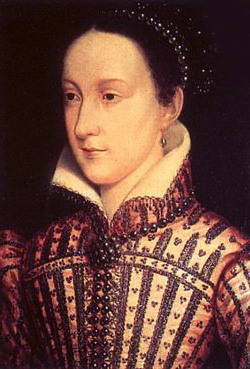Mary I of England and Scotland
Mary Stuart (1542-1604) became Queen six days after her birth when her father, James I, died of cholera.
During the reign of Robert II of Scotland, the Scottish Crown had been confirmed to be inherited by males in the line of Robert's children - all sons - who were listed in that parliamentary act, because the legitimacy of Robert's children of first marriage were questionable. Females and female lines could inherit only after extinction of male lines. All other male lines had deceased years ago, but Duke of Albany, a royal cousin, had lived yet some years ago and died 1536. Had he not died before James V, Mary would not necessarily have inherited. In this sort of Semi-Salic situation, Mary ascended the throne because all other male lines of the royal house had gone extinct before the death of Mary's father.
James Hamilton, 2nd Earl of Arran, the next in line for the throne, acted as Regent (until 1554, when he was succeeded by the Queen's mother, who continued as regent until her own death in 1560).
The new French King, Henri II, was now proposing to unite France, England and Scotland by marrying the little Queen to his newborn son, the Dauphin Francois. This marriage was by proxy, and before the two young people could meet, Francois died.
At Holyrood Palace on July 29, 1565, Mary unexpectedly married Henry Stuart (1545-1567), Lord Darnley, Mary's half-first cousin. Before long, Mary became pregnant, but Darnley soon became arrogant and demanding, insisting on power to go with his courtesy title of "King". He was jealous of Mary's friendship with her private secretary, David Rizzio, and, in March 1566 Darnley entered into a secret conspiracy with the nobles who had rebelled against Mary in the Chaseabout Raid. On the 9th of March a group of the lords, accompanied by Darnley, murdered Rizzio while he was in conference with the queen at Holyrood Palace. This action was the catalyst for the breakdown of their marriage. Darnley soon changed sides again and betrayed the lords. But on another occasion, he attacked Mary and unsuccessfully attempted to cause her to miscarry their unborn child.
Following the birth of the heir, Darnley died--probably of syphilis but gossip said poison.
With the death of Darnley, Mary faced a suspicious and divided northern realm, while her southern kingdom hardly knew her at all. She had spent most of her time in Scotland and the feeling had increasingly grown among some Englishmen that London was beginning to be a colony of Edinburgh. What threatened was actual civil war. But this conflict became ultimately between two nobles--James Hepburn (1534-1578), the Earl of Boswell, and Thomas Howard, Duke of Norfolk (1536-1599)--for her hand in marriage. Boswell ultimately overplayed his hand in 1567 when attempting to abduct the Queen, evidently with the hope of forcing her marriage to him. The plot failed by a lucky chance, and the Earl fled Britain. Norfolk and Mary's half-brother James (1531-1570) persuaded Mary to wed the Duke. Some called their wedding "The Second Unification" of the English and Scottish thrones. But the couple had no male children, so that Mary's son by Darnley ultimately became King.
| Preceded by: James I and V |
Queen of England 1542-1604 |
Succeeded by: James II and VI |
Queen of Scots 1542-1604 |
